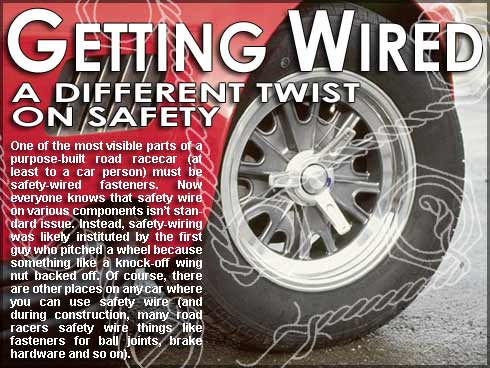| 
By
Wayne Scraba
2/9/05
But this isn’t about what parts are safety-wired. Instead,
it’s about the right way to use safety wire. Remember,
this isn’t about looks. It’s about security. And
a good chunk of parts used in drag racing can (and should
be) safety wired. Here’s some insight:
THE REAL REASON FOR USING SAFETY WIRE…
There are two real reasons why safety wire is used on aircraft,
racing motorcycles, and race cars: The first is pretty obvious:
If a bolt or component is wired into place, you have a pretty
good idea that the fastener was tightened in the first place
(believe it or not, there are plenty of cases where, in the
heat of re-assembly, people forget to tighten stuff).
The second reason is equally obvious: Safety wire is used
so that a bolt or some other fastener doesn’t fall off.
But there’s a catch here: The world’s best job
of “safetying” a fastener won’t stop the
thing from loosening. That’s not the job of the safety
wire. All a piece of safety wire will do is to limit the amount
of rotation available to the fastener, which in turn prevents
it from backing off any further. Keep this and the first reason
in mind when you safety wire bits and pieces together.
PICKING THE WIRE…
To tell you the truth, just about any form of wire can be
used to safety parts together. Some folks have used everything
from iron mechanic’s wire to copper wire to get the
job done in a pinch. But there is a better product, and it’s
dedicated (for the job) -- 302 stainless steel safety wire.
This stuff comes in rolls and it’s available in diameters
of 0.020, 0.032 and 0.041 inches. The most widely used is
the 0.032-inch diameter material, and for the most part, racers
in-the-know use nothing else.
WORKING WITH WIRE…
There are many different ways to twist the wire, but the
easiest is by way of safety wire pliers (as shown in the accompanying
photos). These tools aren’t exactly cheap, but if you
safety-wire pieces on a regular basis, you’ll be glad
you have a set. Very good examples are available from Mr.
Gasket.
To work with the wire, first cut it to length. This is a
case where too much is just about right. The worst thing that
can happen is to find you just ran out of wire right before
the job was finished. It’s a whole lot easier to cut
off excess wire than it is to start the job from scratch.
Next, insert the wire through the hole in the fastener and
loop it around, not over, the head of the fastener in the
direction that tightens the bolt. And keep in mind that some
fasteners can have left hand threads. The bottom line here
is; remember to always install (and then twist) the wire in
the direction that tightens the fastener. Otherwise, the safety
wire can’t do its job.
At this point, pull the wire tight. Figure out how much “twist”
length is required for the job and begin twisting it with
the safety wire pliers. Some people make a mistake by assuming
that the twisting alone will tighten the wire. Not so. The
twisting action is used to take up any slack in the wire.
If you twist the wire too tightly, then you run the risk of
breaking the wire. The general rule for twisting wire is eight
to ten turns per inch. On a similar note, pliers not designed
for safetying have a bad habit of marking the surface of the
wire, which can also cause the wire to break. And keep in
mind that it might break when you least expect it.
It’s almost always a good idea to get the wire as tight
as possible. To accomplish this, try to leave approximately
0.250-inch of untwisted wire before it passes through something
like a second bolt head. This will allow you to pull the wire
tight as you pass the loose end around the fastener head (in
the direction of the fastener tightening).
At this point, you can twist the wire while pulling on it.
You might have to use quite a tug to pull it tight. There
might be a couple of situations where you might want to leave
the safety wire slightly loose. The reason for leaving the
wire a bit on the loose side is this: It allows you to visually
check the safety wire quickly. If the wire has tightened up,
you know that the nut is trying to back off.

|
